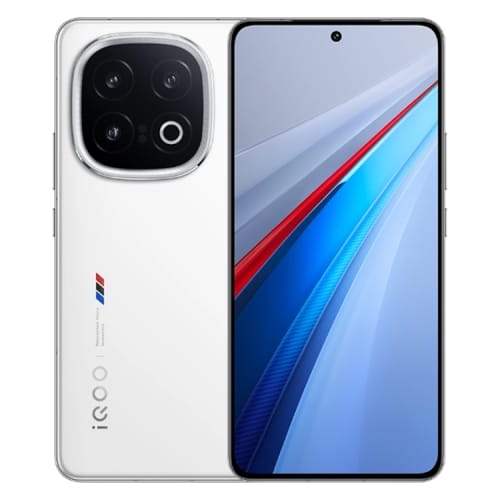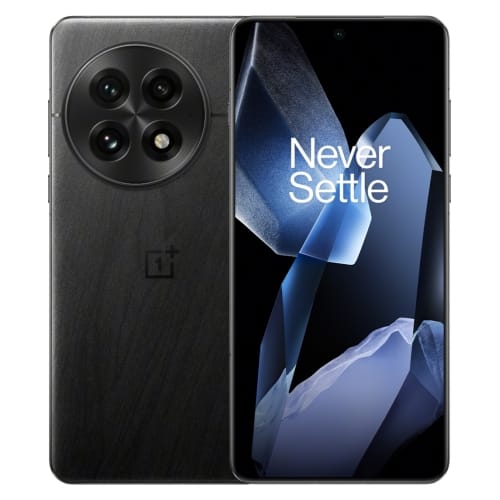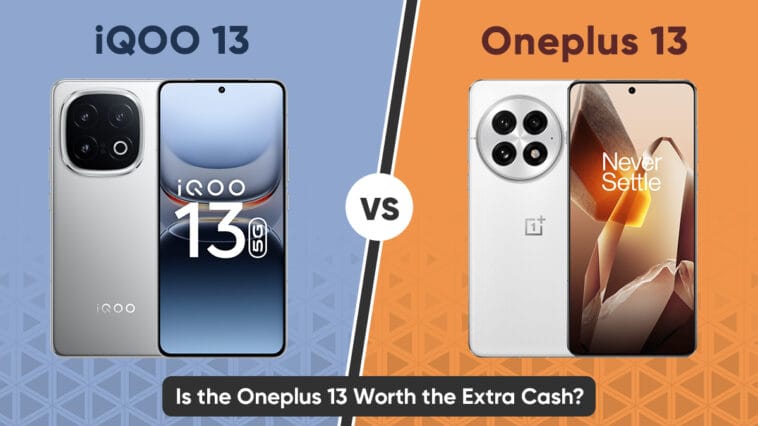Is the more expensive smartphone always necessarily the better choice for your money? In the case of the iQOO 13 vs OnePlus 13, the comparison is no different. Both devices pack top-tier specifications, including the Snapdragon 8 Elite processor and cutting-edge displays, but the price difference raises an important question: is the OnePlus 13 truly worth the premium over its rival?
This detailed comparison dives into the key aspects of each phone to help you decide which one offers the best value for your money. So, let’s get straight into the details of the comparison.
iQOO 13 vs OnePlus 13: Specification Comparison
When comparing the iQOO 13 and the OnePlus 13, it’s striking how closely their specifications align, particularly in core areas like performance, display, and battery capacity. Both devices are powered by the Snapdragon 8 Elite SoC, both sport 6.82-inch LTPO AMOLED panels with QHD+ resolutions, and a peak brightness of 4,500 nits, and both boast LPDDR5X RAM.
Instead of breaking down the similarities between the two devices, we’ll instead focus on addressing the differences between the two. Hopefully, this approach will help you make a better distinction between the two devices and come to a more informed decision.


OnePlus 13 vs iQOO 13 Specification comparison
| Feature | OnePlus 13 | iQOO 13 |
|---|---|---|
| Display | 6.82-inch ProXDR LTPO 4.1 OLED 3168×1440 (QHD+), Quad-curved, 510 ppi 120Hz refresh rate Peak Brightness: Up to 4,500 nits | 6.82-inch LTPO AMOLED 3168×1440 (QHD+), Flat display, 144Hz refresh rate Peak Brightness: Up to 4,500 nits |
| Performance | Snapdragon 8 Elite SoC OxygenOS 15 (Android 15) 12GB/16GB/24GB LPDDR5X RAM 256GB/512GB/1TB UFS 4.0 Storage | Snapdragon 8 Elite SoC Funtouch OS 15 (Android 15) 12GB/16GB LPDDR5X RAM 256GB/512GB UFS 4.1 Storage |
| Battery | 6,000 mAh (Dual-cell) 100W SUPERVOOC™ wired charging 50W AIRVOOC wireless charging 5W reverse charging | 6,000 mAh 120W FlashCharge (wired) |
| Camera | Triple Rear Cameras: - 50 MP Wide Primary (Sony LYT-808 (1.4", 1.12µm - 2.24µm), f/1.6, 23mm, multi-directional PDAF, Laser AF, OIS; 2160p@60fps/4320p@30fps) - 50 MP Ultrawide (Samsung ISOCELL JN5 (1/2.76", 0.64µm - 1.28µm), f/2.0, 15mm, PDAF; 2160p@60fps) - 50 MP 3x Telephoto (Sony LYT-600 (1/1.95", 0.8µm - 1.6µm), periscope lens, f/2.65, 73mm, multi-directional PDAF, OIS; 2160p@60fps) Front Camera: 32MP (Sony IMX615 (1/2.74", 0.8µm - 1.6µm), f/2.45, 21mm, fixed focus; 2160p@60fps | Triple Rear Cameras: - 50 MP Primary (Sony IMX921 f/1.9, 24mm, 1/1.56", 1.0µm, PDAF, OIS; 4320p@30fps ) - 50 MP Ultrawide (Samsung ISOCELL JN1, f/2.0, 15mm, 1/2.76", 0.64µm, autofocus; 2160p@60fp) - 50 MP Telephoto (Sony IMX816, f/1.85, 50mm, 1/2.51", 0.64µm, PDAF; 4320p@30fps) Front Camera: 32 MP (Galaxycore GC32E1 / Hynix hi3231q, f/2.2, 1/3.1", 0.7µm; 2160p@30fps) |
| Other Features | Hasselblad camera collaboration Ceramic Guard screen protection IP68/69 water and dust resistance | Halo Monster Ring with customizable lights In-display ultrasonic fingerprint sensor Stereo speakers IP68/69 water and dust resistance |
| Color Options | - Midnight Ocean - Black Eclipse - Arctic Dawn | - Legend - Nardo Grey |
| Price in India | ₹69,999 (12GB+256GB) ₹76,999 (16GB+512GB) ₹89,999 (24GB+1TB) | ₹54,999 (12GB+256GB) ₹59,999 (16GB+512GB) |
iQOO 13 vs OnePlus 13: Display
Both the iQOO 13 and OnePlus 13 sport similar 6.82-inch LTPO AMOLED panels with QHD+ resolutions. They’re remarkably similar, with two key differences. The refresh rate, and the shape of the display itself. The iQOO 13 also has a brighter display, measuring 1,801 nits under bright sunlight, as opposed to the OnePlus 13’s 1,203 nits.
The OnePlus13 features a quad-curved display, a design element that enhances its premium feel. The edges of the screen curve smoothly in four directions, creating an immersive experience. In contrast, the iQOO 13 opts for a flat display, appealing to users who prioritize practicality and precision. Flat screens are less prone to accidental touches and are often preferred for gaming.
Next, let’s take a look at the refresh rate difference. With a 120Hz refresh rate, the OnePlus 13 ensures smooth animations, seamless scrolling, and a cinematic touch when gaming or watching videos. However, the iQOO 13 takes the lead in fluidity with its 144Hz refresh rate, providing ultra-smooth visuals, especially noticeable in fast-paced games and high-refresh content.
iQOO 13 vs OnePlus 13: Software
While both the OnePlus 13 and iQOO 13 run Android 15 out of the box, their software experiences are distinct, shaped by the custom interfaces each brand provides. The OnePlus 13 runs on OxygenOS 15, while the iQOO 13 uses Funtouch OS 15.
OxygenOS 15 has long been celebrated for its sleek and polished experience. It’s well-optimized, offering smooth animations, minimal bloatware, and intuitive features that enhance usability. OnePlus has fine-tuned OxygenOS 15 to take full advantage of the hardware, ensuring excellent resource management and fluid performance.
On the other hand, Funtouch OS 15 offers a feature-rich experience, packed with customization options, themes, and additional tools. Despite this, it doesn’t quite match the level of optimization that OxygenOS delivers. Funtouch OS has a tendency to be more resource-heavy, and its interface can feel cluttered compared to the clean, near-stock approach of OxygenOS.
iQOO 13 vs OnePlus 13: Internal Storage and RAM
The OnePlus 13 caters to power users and content creators with its three storage tiers: 256GB, 512GB, and a massive 1TB. Paired with 12GB, 16GB, or even 24GB of LPDDR5X RAM, the OnePlus 13 ensures ample space for storing high-resolution photos, 4K videos, and running demanding applications. The use of UFS 4.0 storage delivers exceptional read/write speeds.
The iQOO 13, while offers 256GB and 512GB of storage options, paired with either 12GB or 16GB of LPDDR5X RAM. It also uses the slightly updated UFS 4.1 storage, which brings incremental speed improvements and better power efficiency compared to UFS 4.0. These configurations are more than enough for most, but the absence of a 1TB option might be a drawback for some users.
iQOO 13 vs OnePlus 13: Camera
When it comes to cameras, the OnePlus 13 and iQOO 13 are closely matched, offering powerful triple-lens setups designed for versatility and high-quality photography. However, the OnePlus 13 edges ahead with significantly superior telephoto and nighttime ultra-wide photo capabilities in real-life tests, making it a slightly more compelling choice for photography enthusiasts.
Both smartphones come equipped with 50 MP primary sensors that feature optical image stabilization (OIS). This ensures sharp and detailed photos, even in challenging lighting conditions. Additionally, both models include 50 MP ultra-wide cameras, which provide an expansive field of view—perfect for capturing landscapes or group photos. For everyday photography, either phone delivers excellent results with vibrant colors and crisp details. However, the ultra-wide camera on the iQOO 13 does not perform as well as that of the OnePlus 13, particularly in low-light conditions.
iQOO 13 vs OnePlus 13: Battery and Charging
Both the OnePlus 13 and iQOO 13 come with a large 6,000 mAh battery, with some key differences. The OnePlus 13 features 100W SUPERVOOC™ wired charging and 50W AIRVOOC wireless charging, setting it apart with faster and more versatile charging options.
Meanwhile, the iQOO 13 offers 120W FlashCharge for wired charging, which is one of the fastest in the industry. With this technology, the iQOO 13 can charge from 0% to 100% in just about 20 minutes, making it an ideal choice for users who need quick power-ups during short breaks. However, it lacks the wireless charging capability that the OnePlus 13 provides, which might be a downside for those who prioritize wireless convenience.
iQOO 13 vs OnePlus 13: Pricing and Variants
When considering the OnePlus 13 and iQOO 13, price plays a pivotal role in the decision-making process, especially since both phones offer premium features.
The iQOO 13 comes in at a more affordable price point, with two main configurations:
- ₹54,999 for the 12GB RAM + 256GB storage variant
- ₹59,999 for the 16GB RAM + 512GB storage variant
This makes the iQOO 13 a more budget-friendly option, providing solid flagship features, including the Snapdragon 8 Elite processor, high-refresh-rate display, and 6,000 mAh battery, without the hefty price tag.
On the other hand, the OnePlus 13 is priced higher, reflecting its premium design and additional features, particularly in storage and camera capabilities:
- ₹69,999 for the 12GB RAM + 256GB storage variant
- ₹76,999 for the 16GB RAM + 512GB storage variant
- ₹89,999 for the 24GB RAM + 1TB storage variant
The OnePlus 13’s pricing is notably steeper, especially with the 1TB storage variant, but this reflects the extra premium features, including a quad-curved display, enhanced telephoto lens, ultra-wide camera, and superior optimization in OxygenOS.
As for colour options, the iQOO 13 comes in only two colours in India, that being the signature Legendary, and Nardo Grey. Meanwhile, the OnePlus 13 comes in Midnight Ocean, Black Eclipse and Arctic Dawn, essentially fancy names for dark blue, black and white.
Conclusion
Going back to the original question, is the Oneplus 13 worth the extra cash? We have to say, unless there’s something specific about the OnePlus 13 that you need, we’d say it’s not worth the extra cash. If you’re looking for a feature-packed device at a more affordable price, the iQOO 13 offers incredible value with its 144Hz display, lightning-fast 120W charging, and robust performance.
On the other hand, the OnePlus 13 justifies its premium price with a refined experience. Its quad-curved display, superior telephoto & ultra-wide camera, wireless charging capabilities, and well-optimized OxygenOS 15 make it a top choice for those who seek elegance, versatility, and cutting-edge technology.
But, when you boil it all down, the iQOO 13 simply does almost everything the OnePlus 13 can do. If you have the extra money and want the best experience, need wireless charging or need 1TB of storage, then the OnePlus 13 is a good choice. But if you’re deliberating on saving a bit, then the iQOO 13 is the way to go.
FAQ
A: The OnePlus 13 is IP68 and IP69 certified, meaning it’s more water resistant than most, if all mainstream flagship smartphones available right now. Despite this, while it can handle spills, dips into the water, and splashes better than most devices, it’s still not waterproof, so you don’t exactly want to bring it swimming.
A: Yes, the OnePlus 13 does have eSIM support.
A: The OnePlus 13 sports Ceramic Guard – ‘one of the most durable smartphone display glasses’, according to OnePlus. It’s not Gorilla Glass, and we aren’t exactly sure how good it is compared to Gorilla Glass.
A: No, the iQOO 13 does not support wireless charging sadly.




Comments
Loading…